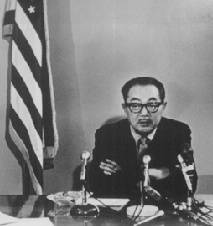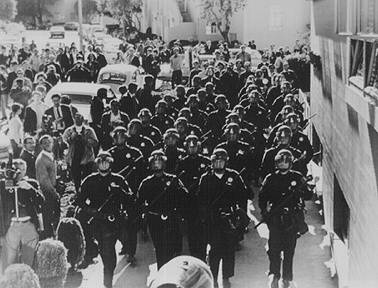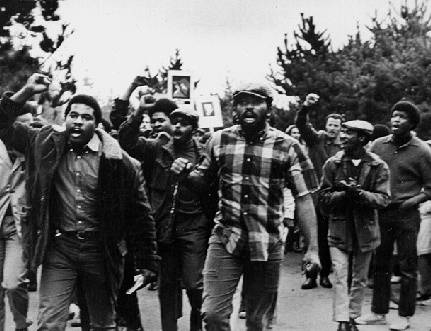San Francisco State Strike: Difference between revisions
No edit summary |
(added page content type) |
||
| Line 1: | Line 1: | ||
'''<font face = Papyrus> <font color = maroon> <font size = 4>"I was there..."</font></font> </font>''' | |||
''by Calvin Welch'' | |||
[[Image:sfsuingl$hayakawa-at-podium.jpg]] | [[Image:sfsuingl$hayakawa-at-podium.jpg]] | ||
| Line 34: | Line 38: | ||
It taught a lot of people at lot of lessons about politics and reality. And about the SFPD and [[Mayor Joe Alioto|Joe Alioto]], and about how it worked. That was the end of the '60s. OK. | It taught a lot of people at lot of lessons about politics and reality. And about the SFPD and [[Mayor Joe Alioto|Joe Alioto]], and about how it worked. That was the end of the '60s. OK. | ||
[[Drugs, Hippies, Protests, & Riots|Prev. Document]] [[STRIKE!... Concerning the 1968-69 Strike at San Francisco State College|Next Document]] | [[Drugs, Hippies, Protests, & Riots|Prev. Document]] [[STRIKE!... Concerning the 1968-69 Strike at San Francisco State College|Next Document]] | ||
[[category:SFSU]] [[category:OMI/Ingleside]] [[category:1960s]] [[category:African-American]] [[category:Dissent]] [[category:riots]] | [[category:SFSU]] [[category:OMI/Ingleside]] [[category:1960s]] [[category:African-American]] [[category:Dissent]] [[category:riots]] | ||
Revision as of 23:47, 4 January 2009
"I was there..."
by Calvin Welch
S.I. Hayakawa, elevated from professor to President of the School during the strike, took a hard line and encouraged police action, eventually becoming one of California's senators in the 1970s.
San Francisco riot police enter campus, 1968.
Photo: Terry Schmitt
One final event that ended the events of the 1960s was the student strike at San Francisco State College ("SFSC"), where there had always been a kind of symbiotic relationship with the Haight Ashbury. I believe the "Haight Ashbury" phenomenon took place in this neighborhood because 1) of the community's connection with SFS, 2) the role of both SFS students and faculty, and 3) the particular role of Ginsberg and Kesey, which is outside the framework of this talk.
I hope I've been able to paint a picture that shows the actual electoral politics in SF was much more conservative than the cultural politics of SF at this time. Nowhere was this more evident than at SFSC. The strike at SFSC has received very little attention--and that's a crime. As far as I'm concerned--I was a student at SFS so I'm kind of biased--it was far more significant than the Free Speech Movement at Berkeley. I guess those guys at Berkeley get better jobs, end up with more money and pay historians and filmmakers to believe it. Those of us who go to State colleges don't have that kind of influence. Maybe we got worse educations, and they're just more articulate. My belief is that they own the media.
The strike at State was exceedingly important. In the first place, it's got symbolic importance, not to mention it launched S.I. Hayakawa, to the embarrassment and chagrin of us all [Hayakawa subsequently ended up in the Senate of the United States -- ed.]. Secondly it's significant in terms of what was happening at State during that time. I came to State out of the valley (Stockton) during the period 1962-1967. I come to SF State, and it's like WOW! First I'm one of about 700 freshmen, and State didn't want freshmen. The average age in 1962 was 26 years old. I'm going to my first class and everyone's smoking cigarettes, in school, in class! What?! This is not Stockton! These people are cool!
A very politically active, culturally active, sexual politics was going on there before anywhere else. It was the sexual liberation age, and Jefferson "Fuck" Poland used to fuck in public as a political statement. But there was also a political reality that these days is hard to believe. The Associated Students at SF State, the student government---everyone got involved. This was serious politics.
It is not an accident that the Black Panther Party was formed in San Francisco. It wasn't formed in Oakland. It was formed here. The push for the Black Panther Party first came from the Black Student Union at SF State, who demanded reparations for slavery, and got a chunk of the ASU money. This is you whiteys paying us back for slavery, and they took a chunk. And they didn't tell anybody where it went.
Black Student Union marchers, San Francisco State strike, 1968.
Photo: Terry Schmitt
A number of later players in redevelopment politics, like WAPAC (Western Addition Project Action Committee) and the people behind the Patty Hearst food distribution in 1974, were at State at that time. People who later appear in neighborhood politics in Chinatown and the Mission were at State. There was even a student university funded by the ASU in which students hired faculty of their own and paid them directly. It was an extraordinary situation, had more than rhetorical control, real financial control, several hundreds of thousands of dollars every semester, and spent it.
The experimental college was formed in 1964-1965. Leroi Jones was invited to be its first chancellor: he insulted us by telling us when he got there that he was Baraka, he was no longer Leroi Jones, and what the fuck are you guys doing, calling me Leroi Jones? We said, well we didn't know you changed your name. And he demanded his salary up front plus additional funds and then he disappeared. The next thing we read is that he's busted in New Jersey after having supposedly just purchased several thousand dollars of guns to arm an insurrection in some town in New Jersey! OK.
What was happening was, in the Mission, in Chinatown, in the Western Addition, students at State were being placed in the external college classes of the Black Student Union ("BSU"). And they started developing a) an understanding of what was going on at this point, and b) a desire to organize, to become organizers, to become involved in the community struggle. But the strikers at State, nominally protesting the BSU and the Golden Gater newspaper, went to the Gator and kicked some people's ass. And the Gator called the police and the nice liberal chancellor didn't know what to do.
To make a long story short, there was kind of a faculty riot as well, observed by this right wing guy S.I. Hayakawa, a world-famous linguist-cum-chancellor that Reagan appointed. For the next year there were pitched battles, occurring virtually daily --- i.e., it's 12 o'clock, time for the battle at the central quad. The TAC unit, straight from the Housing Authority was brought out to State. For a year several hundred SF police, armed to the teeth, were on patrol at SF State. It was a locked-down campus, for an entire academic year. There were cops everywhere. There were no student organizations. You could not hold a rally. There was no free speech. And there was no longer an Associated Student fund. The money stopped. The BSU was declared an illegal campus organization, and was kicked off campus; many other student organizations were declared illegal, banned, pushed off campus, and enforced with the boots of cops! This was not a symbolic show---this was an occupying force for a year!
It taught a lot of people at lot of lessons about politics and reality. And about the SFPD and Joe Alioto, and about how it worked. That was the end of the '60s. OK.



